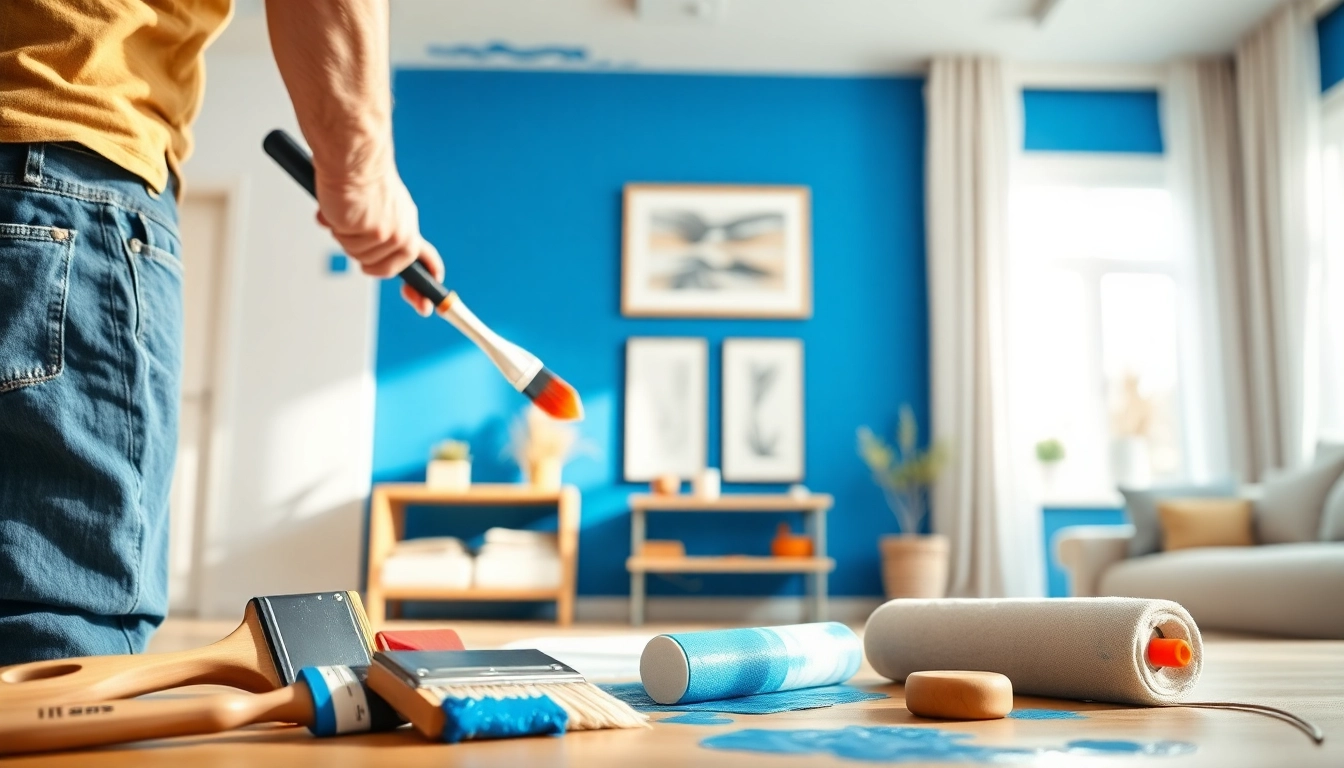Understanding the Basics of Interior Painting
What is Interior Painting?
Interior painting is the process of applying paint to the walls, ceilings, trim, and other surfaces within the interior of a structure. This decorative enhancement not only transforms the look and feel of a space but also offers protective benefits to surfaces against wear, humidity, and other environmental factors. Utilizing quality paint products, techniques, and tools, interior painting can rejuvenate spaces, enhance aesthetics, and even influence mood through color psychology.
Why Choose Professional Interior Painting?
While DIY projects can be rewarding, hiring professionals for interior painting ensures a superior finish. Professionals bring experience, high-quality tools, and techniques that enhance both the process and the outcome. They understand the nuances of color application, surface preparation, and paint restoration. Their expertise minimizes the risk of common pitfalls such as uneven application, drips, and insufficient surface preparation, which can lead to costly rework in the future.
Common Tools and Materials Used
Interior painting requires specific tools and materials to achieve effective results. Common tools include:
- Paint Brushes: For detailed work and trimming.
- Paint Rollers: Ideal for painting large wall areas quickly.
- Paint Trays: Essential for holding paint while working with rollers.
- Painter’s Tape: Prevents paint from smudging onto surfaces that shouldn’t be painted.
- Drop Cloths: Protects floors and furniture from paint spills.
- Ladders: Needed for reaching high ceilings and difficult areas.
In addition to these tools, selecting the right paint type—such as acrylic, latex, or oil-based—is crucial for ensuring durability and ease of cleaning.
Cost Considerations for Interior Painting
Average Costs for Interior Painting Projects
The cost of interior painting varies significantly based on location, room size, type of paint, and labor costs. On average, homeowners can expect to pay between $1,800 and $10,000 for a full interior paint job. A typical breakdown includes:
- Small rooms (e.g., a bathroom or bedroom, 100-150 sq. ft.) range from $300-$800.
- Medium rooms (e.g., kitchen or dining room, 200-300 sq. ft.) typically cost between $600 and $1,200.
- Larger spaces (e.g., living rooms, open concept areas, 400 sq. ft. and up) can run from $900 to $2,000 or more.
Ultimately, the scope of the project and the complexity of the task will dictate the overall expense. Sampling quotes from multiple contractors is advisable for competitive pricing.
Factors Influencing the Cost of Interior Painting
Multiple factors contribute to the cost of interior painting, including:
- Room Size: Larger rooms naturally require more paint and labor.
- Ceiling Height: Tall ceilings may necessitate scaffolding or extension tools, increasing labor costs.
- Paint Quality: Higher-quality paints, while more expensive upfront, often yield better longevity and coverage, minimizing the need for frequent repainting.
- Location: Labor costs can vary significantly based on local market conditions and geographic location.
- Surface Condition: Walls that require extensive pre-painting preparation (patching, sanding, priming) will increase the overall costs.
Budgeting for Paint and Supplies
When budgeting for an interior painting project, consider both the paint and the necessary supplies. Here’s a quick guideline on how to approach budgeting effectively:
- Assess the Area: Measure the surfaces to be painted accurately, including walls, ceilings, and trim, to estimate the amount of paint needed.
- Select Paint Type: Determine if you prefer matte, satin, or gloss finishes and choose paints based on durability and aesthetics.
- Calculate Quantity: One gallon of paint typically covers about 350 square feet with one coat. Factor in the number of coats and surface texture.
- Plan for Supplies: Include all tools required such as brushes, rollers, tapes, and drop cloths in your budget.
- Factor in Labor Costs: If hiring professionals, obtain detailed quotes to understand labor costs involved.
Choosing the Right Colors and Finishes
Interior Painting Color Trends
The significance of color in interior painting cannot be understated. Color trends vary based on current design preferences but typically reflect broader themes in home interiors. For 2023, popular trends include:
- Earth Tones: Shades like terracotta, olive green, and sandy beige create a warm, calming atmosphere.
- Pale Pastels: Soft shades such as blush pink and light lavender are favored for creating serene spaces.
- Bold Accents: Deep colors like navy blue and emerald green are effective in creating focal points and adding personality.
- Neutral Palettes: Whites, grays, and beiges remain classic choices that allow for flexibility in decor.
Understanding Different Paint Finishes
Different finishes can drastically affect the look and functionality of painted surfaces. Here’s a concise overview of common finishes:
- Flat: Offers a non-reflective surface, ideal for low-traffic areas. Difficult to clean.
- Satin: Provides a subtle sheen, perfect for walls in living spaces and ensures easier cleaning.
- Eggshell: A slightly more durable option than flat, suitable for dining and living rooms.
- Gloss: Highly reflective, most durable, and easily cleaned; great for trim and high-traffic areas.
Selecting the right finish is critical for achieving both the desired aesthetic and functional longevity.
Creating Your Color Palette
Establishing a cohesive color palette involves considering the overall theme of your home and the purpose of each room. Follow these steps to create a harmonious color scheme:
- Select a Base Color: Choose a primary color that resonates with your style.
- Choose Complementary Colors: Utilize a color wheel to identify complementary or analogous colors for balance.
- Consider Room Function: Think about how colors affect mood—soft blues for tranquility, bold reds for energy.
- Sample and Test: Purchase sample pots and paint swatches to view colors under different lighting before committing.
Best Practices for Interior Painting
Preparation Steps for Interior Painting
Preparation is key to a successful paint job. Follow these steps to prepare effectively:
- Clear the Area: Move furniture and cover belongings with drop cloths to protect them from paint splatter.
- Clean Surfaces: Remove dust and grease from walls to enhance paint adhesion.
- Repair Walls: Fix holes and imperfections with spackle and ensure surfaces are smooth.
- Prime if Necessary: Use a primer for new or patched areas to ensure even coverage.
Techniques for a Smooth Application
Executing a smooth paint application requires techniques that ensure an even finish:
- Start with the Ceiling: Paint the ceiling first to catch any drips that can be easily covered later.
- Use Painter’s Tape: Apply tape along edges and trim to ensure straight lines.
- Employ the “W” Technique: Use a roller to create a “W” pattern for even distribution of paint before filling in the gaps.
- Maintain a Wet Edge: Work in sections to prevent lap marks as you move around the room.
Post-Painting Touch-ups and Maintenance
After painting, it’s essential to conduct touch-ups and maintenance to keep your project looking fresh. Consider these practices:
- Inspect for Missed Spots: Examine walls and touch up any areas that need more paint.
- Clean Brushes and Tools: Thoroughly clean all brushes and tools to maintain their integrity for future use.
- Establish Maintenance Routines: Clean walls periodically with gentle detergents and keep an eye out for wear and tear.
Hiring Professional Painters vs. DIY
Benefits of Hiring Interior Painting Professionals
Hiring professionals for an interior paint job offers several advantages. They typically provide:
- Quality Results: Experts deliver a polished finish that aligns with your vision.
- Time Efficiency: Professionals can complete the work faster, allowing you to enjoy the revamped space sooner.
- Expert Knowledge: Painters can advise on materials, techniques, and color palettes suited for your home.
- Insurance and Guarantee: Many professional services offer warranties covering their workmanship.
How to Choose the Right Painter
Selecting the right painting contractor involves several critical steps:
- Research Options: Read reviews and ask for recommendations from friends or family.
- Verify Credentials: Ensure the contractor is licensed, bonded, and insured to protect your property.
- Request Estimates: Obtain detailed quotes from multiple contractors to compare costs and services.
- Check References: Speak with prior clients to gain insights into the contractor’s capabilities and reliability.
DIY Interior Painting: Tips for Success
If you opt to handle the painting yourself, keep these tips in mind for a successful project:
- Plan Ahead: Set a timeline and ensure you have all the necessary materials before starting.
- Invest in Quality Tools: Using the right tools can make a considerable difference in the ease of application and the final result.
- Stay Organized: Keep your work area tidy to maintain efficiency and minimize mistakes.
- Learn Techniques: Research and practice painting techniques to improve your skills.



